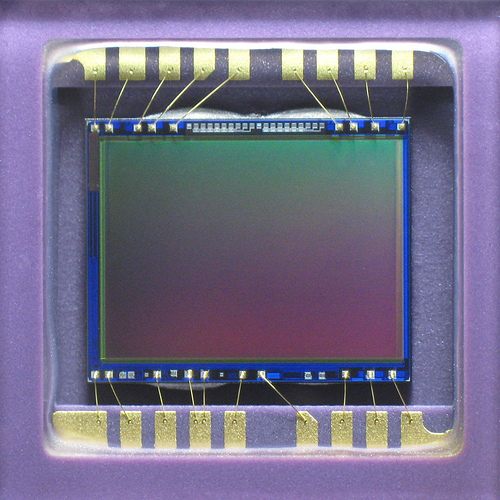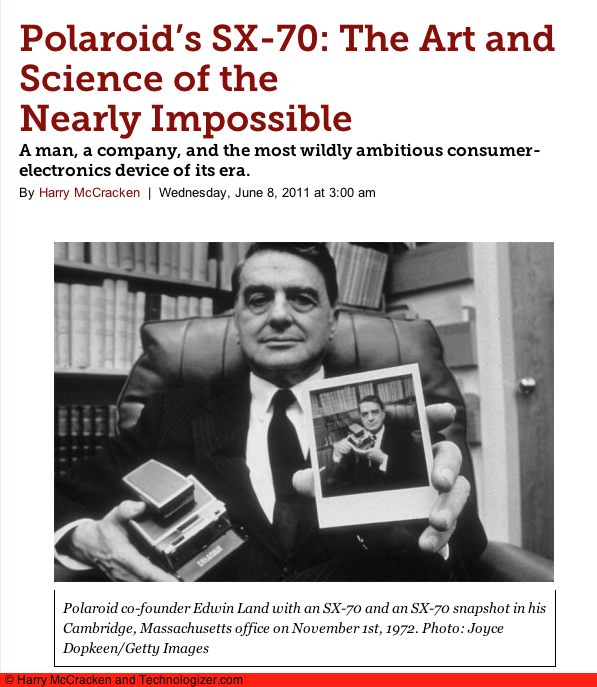The Real Thing.
It has long seemed to me that the greatest photographic invention is the digital sensor. It made immediate and cheap what was either seriously delayed – processing, printing in the film days – or very costly – Polaroid instant pictures. And it also made cameras better in every way – sharper, faster, smaller and more reliable. But there’s no naming the inventor of the digital sensor. The technology is so complex, the manufacturing process so capital intensive, that only committees of scientists and technologists could invent something like this.

The greatest photographic invention ever.
Until the digital sensor came along you could easily identify the great inventors who moved the technology of photography forward. In the nineteenth century they included Niepce (often credited with the first ever photograph dated 1826), Fox Talbot (calotype permanent images, 1834) and Daguerre (silver Daguerrotype images, 1839). George Eastman’s invention of roll film in 1884 made the taking of multiple pictures easy, allied with his preloaded Kodaks which you simply exchanged for a new one when dropping off the old to have the pictures processed. Eastman saw that messing with plate cameras and dark slides, all to take one picture, was not the future.
But it wasn’t until the twentieth century that four giants bestrode the field making quantum leaps in photographic technology. Interestingly, the invention of each was spurred by simple personal desire to make things easier, lighter or faster.
The first was Oskar Barnack of Ernst Leitz to whose failing health we owe the Leica. Barnack got tired of humping his heavy plate camera and tripod around in the mountains so came up with something light and pocketable to help allay his asthma. It didn’t hurt that he was a master engineer or that he had the inspiration of using 35mm movie film stock to allow 36 snaps to be taken on one roll.
The next two were ‘Man and God’ as they were known in Kodak’s Rochester factories. Leopold Mannes and Leopold Godowsky were geniuses like they used to make them, and their chemistry skills gave the world its first usable color film, Kodachrome. Mannes and Godowsky were amateur tinkerers in pursuit of a dream and Kodak had the genius to give them time, space and capital to pursue their dream of a stable color emulsion. The result was the greatest film ever made, before digital swept aside all before it.
But to my mind, the greatest inventor of all, when lone inventors still existed, was Edwin Land. His daughter’s insistence on seeing the picture right after it was taken led this engineering and chemistry titan to come up with the Polaroid process. The original design required you to pull out the print/developer sandwich whose chemical sacks would open when squeezed by the rollers in the camera’s body, initiating processing, and a minute later you would have a moist print in one hand and the discarded caustic chemical part in the other. You would then have to coat the print with the provided squeegee to fix the image and prevent fading. Later, Land made a color version and I have nothing but warm memories of using both and, yes, you really did not want to touch those chemicals. I can still smell the odor of the fixer as if it was yesterday when I last took a Polaroid picture, in much the same way as I recall the aroma of a fresh roll of Kodachrome. Thanks to the Polaroid process, the thrill of the darkroom was now in your hand, and no work or blackout blind were required.
But Land was not to be satisfied. All that chemical detritus got to him and he determined to do better. His invention of a new process which would obsolete the separate tear-off chemical step and have the color picture develop in broad daylight dictated not only a huge step in chemistry but also required the invention of a completely new camera, the SX70. The history of those inventions is described in fascinating detail in Harry McCracken’s Technologizer blog, and you can read the whole story by clicking the image below.

Click the image for the article.
As McCracken elegantly writes:
“But greatness isn’t a popularity contest – not primarily one, at least. Maybe it has more to do with the concept expressed by Arthur C. Clarke’s Third Law: making technology indistinguishable from magic. By that measure, I can’t think of a greater gadget than the SX-70 Land Camera, the instant camera that Polaroid introduced in April 1972. We ranked the SX-70 eighth on that 2005 list, but the sheer magnitude of its ambition and innovation dwarfs the Walkman, iPod, and nearly every other consumer-electronics product you can name.”
In our modern world we adulate carnival barkers like Steve Jobs or copyists like Bill Gates. These two excelled at taking someone else’s idea and either slickly repackaging that which they did not invent or using monopoly power to sell mediocre products with no competition. Edwin Land was not of that caste. Along with Niepce, Daguerre, Fox Talbot, Barnack, Mannes and Godowsky, he was the Real Thing.